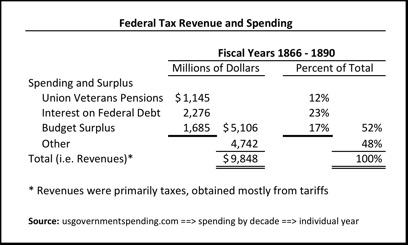As the Sesquicentennial of Reconstruction progresses and the popular press debates whether slavery merits reparations, few students of the era realize that Southerners have already paid a form of reparations; if not for slavery, then as a penalty for the war.
As the table below illustrates, for at least twenty-five years after the war three items represented more than half of the federal budget: (1) budget surpluses to repay federal war debt, (2) interest on federal war debt, and (3) Union veterans pensions. Former Confederates derived no benefit from such items, yet they had to pay their share of federal taxes to fund them. If the Confederacy had been an independent defeated foe such payments would have been reparations.
But the table does not tell the whole story.
First, four years after the war in 1869 the Republican-controlled federal government passed a law that required federal debt to be redeemed in gold. But during the war the great majority of investors used paper money, which traded at a discount to gold, to buy the bonds. The discount got as high as 63%—meaning that a paper dollar was worth only thirty-seven cents—after Union General Grant sustained heavy casualties in the 1864 overland campaign only to be stalemated at Petersburg. In short, gold redemption was a huge windfall for the bondholders. Few, if any, bonds were held by ex-Confederates. Most of the bonds were held by national banks which were required to buy them as monetary reserves under the 1863 National Banking Act, but other Northerners also owned the bonds. Bond interest also had to be paid in gold which was another windfall to Northerners.
Second, Union veterans pensions did not stop growing until 1921, which was fifty-five years after the war ended. Moreover, the total amount paid was about twice as much as the combined federal and Northern state governments spent to fight the war. By 1893 Union veterans pensions represented 40% of federal spending.







